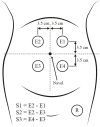Enhancing classification of preterm-term birth using continuous wavelet transform and entropy-based methods of electrohysterogram signals
- PMID: 36704040
- PMCID: PMC9873347
- DOI: 10.3389/fendo.2022.1035615
Enhancing classification of preterm-term birth using continuous wavelet transform and entropy-based methods of electrohysterogram signals
Abstract
Introduction: Despite vast research, premature birth's electrophysiological mechanisms are not fully understood. Prediction of preterm birth contributes to child survival by providing timely and skilled care to both mother and child. Electrohysterography is an affordable, noninvasive technique that has been highly sensitive in diagnosing preterm labor. This study aimed to choose the more appropriate combination of characteristics, such as electrode channel and bandwidth, as well as those linear, time-frequency, and nonlinear features of the electrohysterogram (EHG) for predicting preterm birth using classifiers.
Methods: We analyzed two open-access datasets of 30 minutes of EHG obtained in regular checkups of women around 31 weeks of pregnancy who experienced premature labor (P) and term labor (T). The current approach filtered the raw EHGs in three relevant frequency subbands (0.3-1 Hz, 1-2 Hz, and 2-3Hz). The EHG time series were then segmented to create 120-second windows, from which individual characteristics were calculated. The linear, time-frequency, and nonlinear indices of EHG of each combination (channel-filter) were fed to different classifiers using feature selection techniques.
Results: The best performance, i.e., 88.52% accuracy, 83.83% sensitivity, and 93.22% specificity, was obtained in the 2-3 Hz bands using Medium Frequency, Continuous Wavelet Transform (CWT), and entropy-based indices. Interestingly, CWT features were significantly different in all filter-channel combinations. The proposed study uses small samples of EHG signals to diagnose preterm birth accurately, showing their potential application in the clinical environment.
Discussion: Our results suggest that CWT and novel entropy-based features of EHG could be suitable descriptors for analyzing and understanding the complex nature of preterm labor mechanisms.
Keywords: electrohysterography; entropy; machine learning; preterm labor; time-frequency analysis; uterine electromyogram.
Copyright © 2023 Romero-Morales, Muñoz-Montes de Oca, Mora-Martínez, Mina-Paz and Reyes-Lagos.
Conflict of interest statement
The authors declare that the research was conducted in the absence of any commercial or financial relationships that could be construed as a potential conflict of interest.
Figures





Similar articles
-
Prediction of Preterm Labor from the Electrohysterogram Signals Based on Different Gestational Weeks.Sensors (Basel). 2023 Jun 27;23(13):5965. doi: 10.3390/s23135965. Sensors (Basel). 2023. PMID: 37447815 Free PMC article.
-
Novel Multichannel Entropy Features and Machine Learning for Early Assessment of Pregnancy Progression Using Electrohysterography.IEEE Trans Biomed Eng. 2022 Dec;69(12):3728-3738. doi: 10.1109/TBME.2022.3176668. Epub 2022 Nov 21. IEEE Trans Biomed Eng. 2022. PMID: 35604992
-
Characterization and automatic classification of preterm and term uterine records.PLoS One. 2018 Aug 28;13(8):e0202125. doi: 10.1371/journal.pone.0202125. eCollection 2018. PLoS One. 2018. PMID: 30153264 Free PMC article.
-
Electrohysterography in the diagnosis of preterm birth: a review.Physiol Meas. 2018 Feb 26;39(2):02TR01. doi: 10.1088/1361-6579/aaad56. Physiol Meas. 2018. PMID: 29406317 Review.
-
Accuracy of frequency-related parameters of the electrohysterogram for predicting preterm delivery: a review of the literature.Obstet Gynecol Surv. 2009 Aug;64(8):529-41. doi: 10.1097/OGX.0b013e3181a8c6b1. Obstet Gynecol Surv. 2009. PMID: 19624864 Review.
Cited by
-
Prediction of Preterm Labor from the Electrohysterogram Signals Based on Different Gestational Weeks.Sensors (Basel). 2023 Jun 27;23(13):5965. doi: 10.3390/s23135965. Sensors (Basel). 2023. PMID: 37447815 Free PMC article.
-
Predicting risk of preterm birth in singleton pregnancies using machine learning algorithms.Front Big Data. 2024 Feb 29;7:1291196. doi: 10.3389/fdata.2024.1291196. eCollection 2024. Front Big Data. 2024. PMID: 38495848 Free PMC article.
-
Peak amplitude of the normalized power spectrum of the electromyogram of the uterus in the low frequency band is an effective predictor of premature birth.PLoS One. 2024 Sep 12;19(9):e0308797. doi: 10.1371/journal.pone.0308797. eCollection 2024. PLoS One. 2024. PMID: 39264880 Free PMC article.
-
Enhancing uterine contraction detection through novel EHG signal processing: a pilot study leveraging the relationship between slow and fast wave components to improve signal quality and noise resilience.Front Physiol. 2025 May 27;16:1568919. doi: 10.3389/fphys.2025.1568919. eCollection 2025. Front Physiol. 2025. PMID: 40496244 Free PMC article.
References
-
- OMS . Born too soon: The global action report on preterm birth. Genove: World Health Organization; (2012).
-
- Escalante-Gaytán J, Esquivel-Arizmendi C, Ledesma-Ramírez C, Pliego-Carrillo A, García-González M, Reyes-Lagos J. Utilidad de la electrohisterografía como técnica de monitorización uterina en el ámbito clínico: revisión bibliográfica. Ginecol Obstet Mex (2019) 87(1):46–59. doi: 10.24245/gom.v87i1.2565 - DOI
-
- Vlemminx M, Thijssen K, Bajlekov G, Dieleman J, Der Jagt B, Oei G. Electrohysterography for uterine monitoring during term labour compared to external tocodynamometry and intra-uterine pressure catheter. Eur J Obstetrics Gynecology Reprod Biol (2017) 215):197–205. - PubMed
-
- Frenken M, Thijssen K, Vlemminx M, Van den Heuvel E, Westerhuis M, OEI G. Clinical evaluation of electrohysterography as method of monitoring uterine contractions during labor: A propensity score matched study. Eur J Obstetrics Gynecology Reprod Biol (2021) 259:178–84. - PubMed
Publication types
MeSH terms
LinkOut - more resources
Full Text Sources
Other Literature Sources

